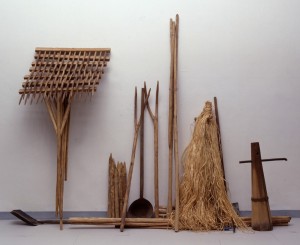Leading agriculturalists, politicians and intellectuals got together this March to explore how Roman farming techniques can help us protect the environment in 2011.
The setting was Italy’s leading school of agriculture in Florence and the occasion was to mark 50 years of a journal of farming history, namely Rivista di storia dell’ agricoltura.
This publication would have been seven years old when Pascali made Farm Tools, so here both the artwork and the academic world appear to have been ploughing the same furrow.
Both ventures seem to express the Italian tendency to cast back in time to antiqiuity. Understandable, but artists had previously been more interested in art and architecture than farming.
This may have been an oversight, mind you. Historian Pliny the Elder makes an observation on the very theme which must have informed the arte povera movement:
“In what manner then are lands to be cultivated to the best advantage? In the cheapest manner if it is good, or by good bad things.†Source: this 19th century encyclopaedia.
Received wisdom and perhaps revived wisdom said that you could give the land too much “culture†or cultivation. And the same might be said of an audience, so Pascali uses rudimentary tools.
Once they are propped against a gallery wall, they remind me, if nothing else, of how little I know about rural life. So “good bad things†indeed, to quote Pliny quoting the ancients.
This work is on show at Camden Arts Centre, London, until 1 May 2011, in the Pino Pascali show mentioned in the last post.
